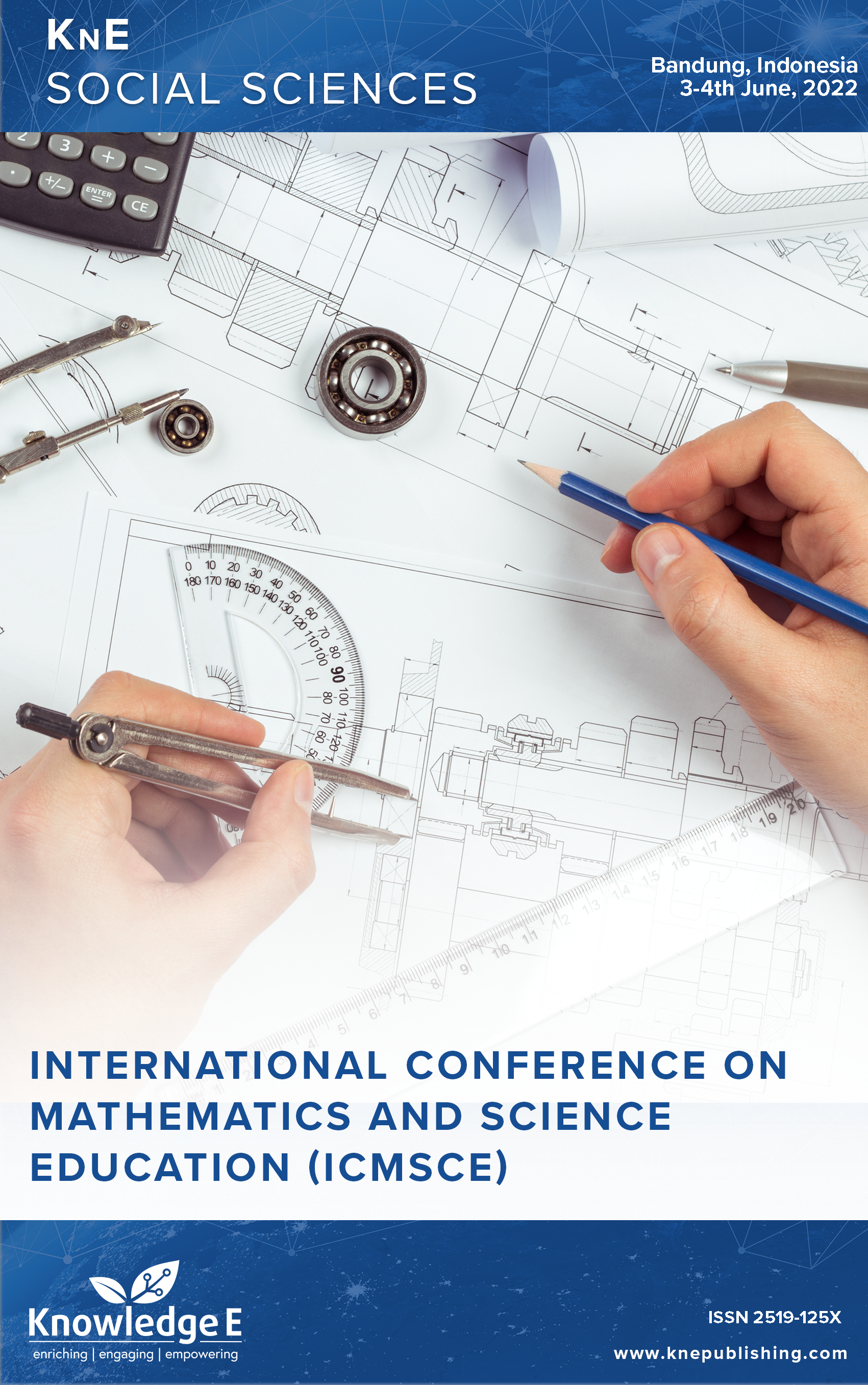Developing Multitier Open-ended Transverse Wave Instrument (MOTWI): How to Assess Students' Misconceptions?
DOI:
https://doi.org/10.18502/kss.v9i13.16006Abstract
At school, students have studied the characteristics of waves and the relationship between period, frequency, wavelength, and the speed of propagation of transverse waves. However, students often experience misconceptions based on intuitive thinking and the phenomena they encountered. Thus, the research aims to describe the instrument validation of developing a multitier open-ended transverse wave instrument (MOTWI), which is useful in deeply assessing the misconceptions of high school students. The 4D (defining, designing, developing, and disseminating) model has been utilized as the method for developing the instrument. The participants were 67 high school students aged between 16 and 18 years (21 males namely “Mas” and 46 females namely “Mba”). The validity and reliability of MOTWI were analyzed using Rasch Model with MINISTEP 4.7.0.0 software. MOTWI validity from item dimensionality was valid. Cronbach Alpha (α) value was 0.75 (good category), and item reliability was a very good category. The construct validation results of MOTWI were valid and reliable for seven items. The students’ conceptions and misconceptions were analyzed with Wright maps. The conceptions of students were categorized as sound understanding (SU), partial understanding positive (PUP), partial understanding negative (PUN), no understanding (NU), misconception (MC), and no oding (NC). The misconceptions were mostly found in the characteristics and the factors that affect the speed of propagation of transverse waves. In conclusion, developing MOTWI can be used to assess and identify conceptions and misconceptions of students.
Keywords: Multitier Open-ended Transverse Wave Instrument, students’ misconceptions
References
G. Ozkan and G.S. Selcuk, “The effectiveness of conceptual change texts and context-based learning on students’ conceptual achievement,.” Journal of Baltic Science Education. vol. 14, no. 6, pp. 753–763, 2015. DOI: https://doi.org/10.33225/jbse/15.14.753
A. Samsudin, D. Rusdiana, R. Efendi, N.J. Fratiwi, A.H. Aminudin, and R. Adimayuda, “Development of Predict-Observe-Explain (POE) strategy assisted by rebuttal texts on Newton’s Law material with Rasch Analysis,.” Tadris: Jurnal Keguruan dan Ilmu Tarbiyah. vol. 6, no. 1, pp. 103–115, 2021. DOI: https://doi.org/10.24042/tadris.v6i1.7641
N. Suprapto, T.-S. Chang, and C.-H. Ku, “Conception of learning physics and self-efficacy among indonesian university students.,” Journal of Baltic Science Education. vol. 16, no. 1, pp. 7–19, 2017. DOI: https://doi.org/10.33225/jbse/17.16.07
D. Kaltakci Gurel, A. Eryilmaz, and L.C. McDermott, “A review and comparison of diagnostic instruments to identify students’ misconceptions in science,.” EURASIA Journal of Mathematics, Science and Technology Education. vol. 11, no. 5, p. 2015. DOI: https://doi.org/10.12973/eurasia.2015.1369a
P. Barniol and G. Zavala, “The mechanical waves conceptual survey: An analysis of university students’ performance, and recommendations for instruction.2016,.” EURASIA Journal of Mathematics, Science and Technology Education. vol. 13, no. 3, p. 2016. DOI: https://doi.org/10.12973/eurasia.2017.00651a
L.M. Goodhew, A.D. Robertson, P.R.L. Heron, and R.E. Scherr, “Student conceptual resources for understanding mechanical wave propagation.,” Physical Review Physics Education Research. vol. 15, no. 2, p. 020127, 2019. DOI: https://doi.org/10.1103/PhysRevPhysEducRes.15.020127
I. Caleon and R. Subramaniam, “Addressing students’ alternative conceptions on the propagation of periodic waves using a refutational text,.” Physics Education. vol. 48, no. 5, pp. 657–663, 2013. DOI: https://doi.org/10.1088/0031-9120/48/5/657
A. Tongchai, M.D. Sharma, I.D. Johnston, K. Arayathanitkul, and C. Soankwan, “Consistency of students’ conceptions of wave propagation: Findings from a conceptual survey in mechanical waves,.” Physical Review Special Topics - Physics Education Research. vol. 7, no. 2, p. 020101, 2011. DOI: https://doi.org/10.1103/PhysRevSTPER.7.020101
G.P. Perdana, K. Suma, and N.M. Pujani, “The effect of conceptual change text structure on concept understanding and misconception reduction of dynamic electricity.,” In: InSHS Web of Conferences 2018. pp. 75. EDP Sciences (2018). DOI: https://doi.org/10.1051/shsconf/20184200075
L. Xie, Q. Liu, H. Lu, et al., “Student knowledge integration in learning mechanical wave propagation.,” Physical Review Physics Education Research. vol. 17, no. 2, p. 020122, 2021. DOI: https://doi.org/10.1103/PhysRevPhysEducRes.17.020122
A. Tongchai, M.D. Sharma, I.D. Johnston, K. Arayathanitkul, and C. Soankwan, “Developing, evaluating and demonstrating the use of a conceptual survey in mechanical waves.,” International Journal of Science Education. vol. 31, no. 18, pp. 2437–2457, 2009. DOI: https://doi.org/10.1080/09500690802389605
N. Janeusse, A. Samsudin*, T. Ramlan, et al., “Developing MeMoRI on Newton’s Laws: For identifying Students’ Mental Models,.” European Journal of Educational Research. vol. 9, no. 2, pp. 699–708, 2020. DOI: https://doi.org/10.12973/eu-jer.9.2.699
A.H. Aminudin, İ. Kaniawati, E. Suhendi, A. Samsudin, B. Coştu, and R. Adimayuda, “Rasch analysis of Multitier Open-ended Light-Wave Instrument (MOLWI): Developing and assessing second-years sundanese-scholars alternative conceptions.,” Journal for the Education of Gifted Young Scientists. vol. 7, no. 3, pp. 557–579, 2019. DOI: https://doi.org/10.17478/jegys.574524
M. Lengkong, E. Istiyono, B.A.O. Rampean, A.M.R. Tumanggor, and M.F.T. Nirmala, “Development of two-tier test instruments to detect student’s physics misconception,.” In: In7th International Conference on Research, Implementation, and Education of Mathematics and Sciences (ICRIEMS 2020) 2021 Mar 8. pp. 561– 566. Atlantis Press (2021). DOI: https://doi.org/10.2991/assehr.k.210305.082
I. Caleon and R. Subramaniam, “Development and application of a threetier diagnostic test to assess secondary students’ understanding of waves,.” International Journal of Science Education. vol. 32, no. 7, pp. 939–961, 2010. DOI: https://doi.org/10.1080/09500690902890130
A. Samsudin, P.B. Cahyani, P. Purwanto, et al., “Development of a multitier openended work and energy instrument (MOWEI) using Rasch analysis to identify students’ misconceptions,.” Cypriot Journal of Educational Sciences. vol. 16, no. 1, pp. 16–31, 2021. DOI: https://doi.org/10.18844/cjes.v16i1.5504
R. Adimayuda, A.H. Aminudin, I. Kaniawati, E. Suhendi, and A. Samsudin, “A multitier open-ended momentum and impulse (MOMI) instrument: Developing and assessing quality of conception of 11th grade sundanese students with rasch analysis.,” International Journal of Scientific and Technology Research. vol. 9, no. 2, pp. 4799– 4804, 2020.
N. Suprapto, “Do we experience misconceptions?: An Ontological review of misconceptions in science.,” Studies in Philosophy of Science and Education. vol. 1, no. 2, pp. 50–55, 2020. DOI: https://doi.org/10.46627/sipose.v1i2.24
A. Suhandi, Y. Surtiana, I. Husnah, et al., “Fostering high school students’ misconception about boiling concept using Conceptual Change Laboratory (CCLab) activity,.” Universal Journal of Educational Research. vol. 8, no. 6, pp. 2211–2217, 2020. DOI: https://doi.org/10.13189/ujer.2020.080603
G.J. Postner, K.A. Strike, P.W. Hewson, and W.A. Gertzog, “Accommodation of a scientific conception: Toward a theory of conceptual change.,” Science Education. vol. 66, no. 2, pp. 211–27, 1982. DOI: https://doi.org/10.1002/sce.3730660207

